We are building a Snowland Eco-Farm in Nepal
Our new Nepal project starting in 2019 in the 2015 earthquake zone, northeast of Kathmandu: where will we be in 2022?
We have been working in Nepal since the earthquake in 2015 – even before the Snowland Children Foundation was founded! You can find the completed projects under “Successes”.
Our latest project is an ecological farm (Eco-Farm) with guest house and Eco-Café still in Timbu, only 65 km away from Kathmandu, but still a day’s journey by off-road vehicle!
In 2019 we have started this ambitious project, which should bring the village and especially the existing “Woman’s Association” (Cooperative) more money than for mere survival.
Our ultimate goal is to keep the youth in the village and prevent them from migrating to the “Moloch” Kathmandu or even further abroad and then missing in Nepal!
In 2019 we built the first two large greenhouses. In 2020 we continued – despite Corona restrictions – and were able to build another 2 commercial greenhouses!
With these 4 greenhouses, the 35 women of the “Woman’s Association” in Timbu (with 85 families in the village) are able to generate a good additional income and of course to supply the village itself with more vegetables!
But – read the details yourself and look at the many interesting pictures! Here you can also upload two pdf with a detailed report and many pictures until spring 2020!
In 2020, of course, no one from Switzerland could visit Nepal because of the Corona pandemic. So we could only log and describe the two other greenhouses from a distance!
2022 it was then possible to visit Nepal and also Timbu again in May. The trip to Timbu was more than frightening: The consequences of the monsoon of 2021 were hardly removed even 9 months later, half-sunken houses rose from the rubble, the “road” (gravel road) ran partly UNDER the riverbed. Heavy equipment to bake out the riverbed was hardly to be seen. With these impressions we were not surprised that the monsoon in August 2022 – although rather a “normal” monsoon, again caused severe devastation of the road but also riverbed!
In Timbu itself we were a little bit surprised: A big Japanese organization / foundation JICA has “nested” there and has occupied the women of the cooperative with the weaving of Tibetan fabrics (good idea) and the production of stuffed animals (not a good idea). For this purpose they have set up looms in one community house and several sewing machines in another house. The consequence for us was that the women neglected the greenhouses!
As a result, we have sought contact with the Japanese Foundation and will certainly be able to solve the problem. We hope for a cooperation and possibly even a financial support, because this JICA is a worldwide organization with VERY much financial power.
Frühjahr (Mai) 2022: Endlich wieder in Nepal!
– Die Foto-Strecke 1 – Es beginnt in Kathmandu…

Ankunft in Kathmandu

Auch die Tauben dürfen NIE fehlen!

So kennt man das grösste Heiligtum ausserhalb Tibets

Der Boudhanath bei Nacht
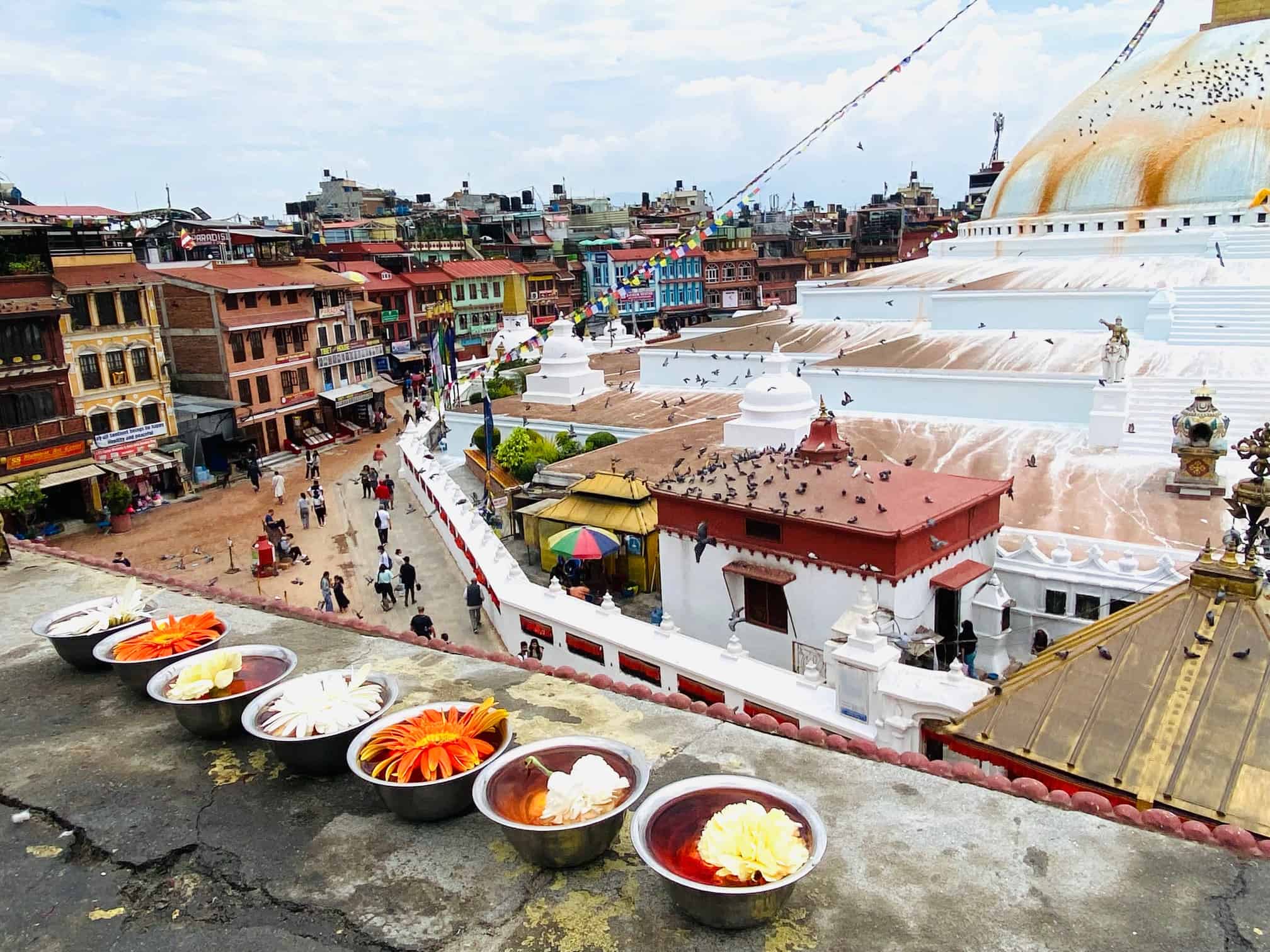
Der Boudhanath von oben

Vermutlich gibt es in Kathmandu fast so viele Mönche wie Einwohner

Der Cora-Walk – 365 Tage im Jahr….

Mein Arbeitsplatz im Hotel

Auch Tempel gibt es unzählige in dieser Stadt, wo doch so viele Volksgruppen zusammen leben
– Die Foto-Strecke 2 – Die Fahrt nach Timbu – ein schreckliches Erlebnis der Monsun-Verwüstung

Man kennt den Melamchi River

Ein einsamer Bagger – Tropfen auf den heissen Stein….

ohne Worte…

Der zweite und letzte Bagger, den wir sehen…
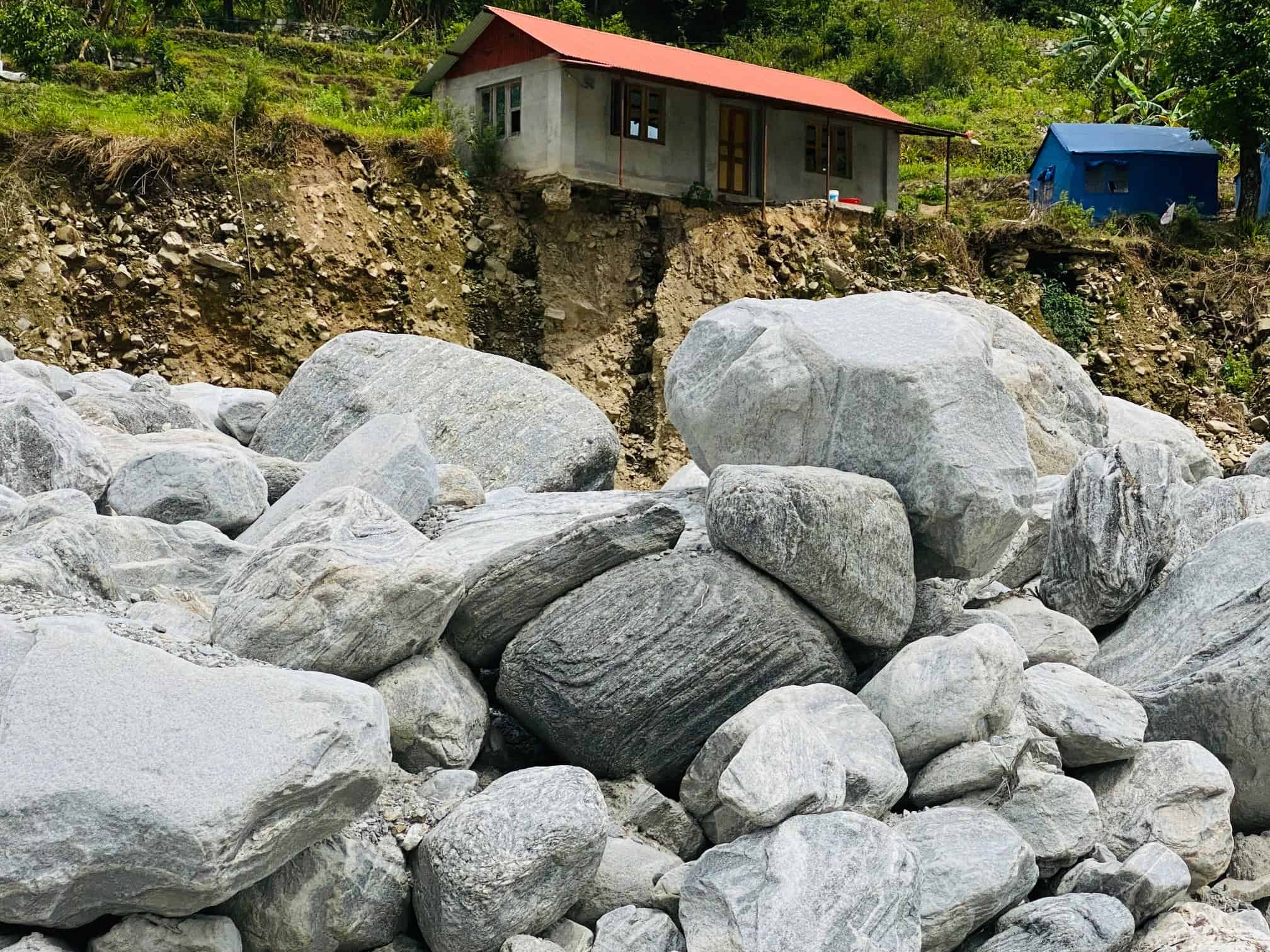
Dieses Haus hängt halb über dem Abgrund
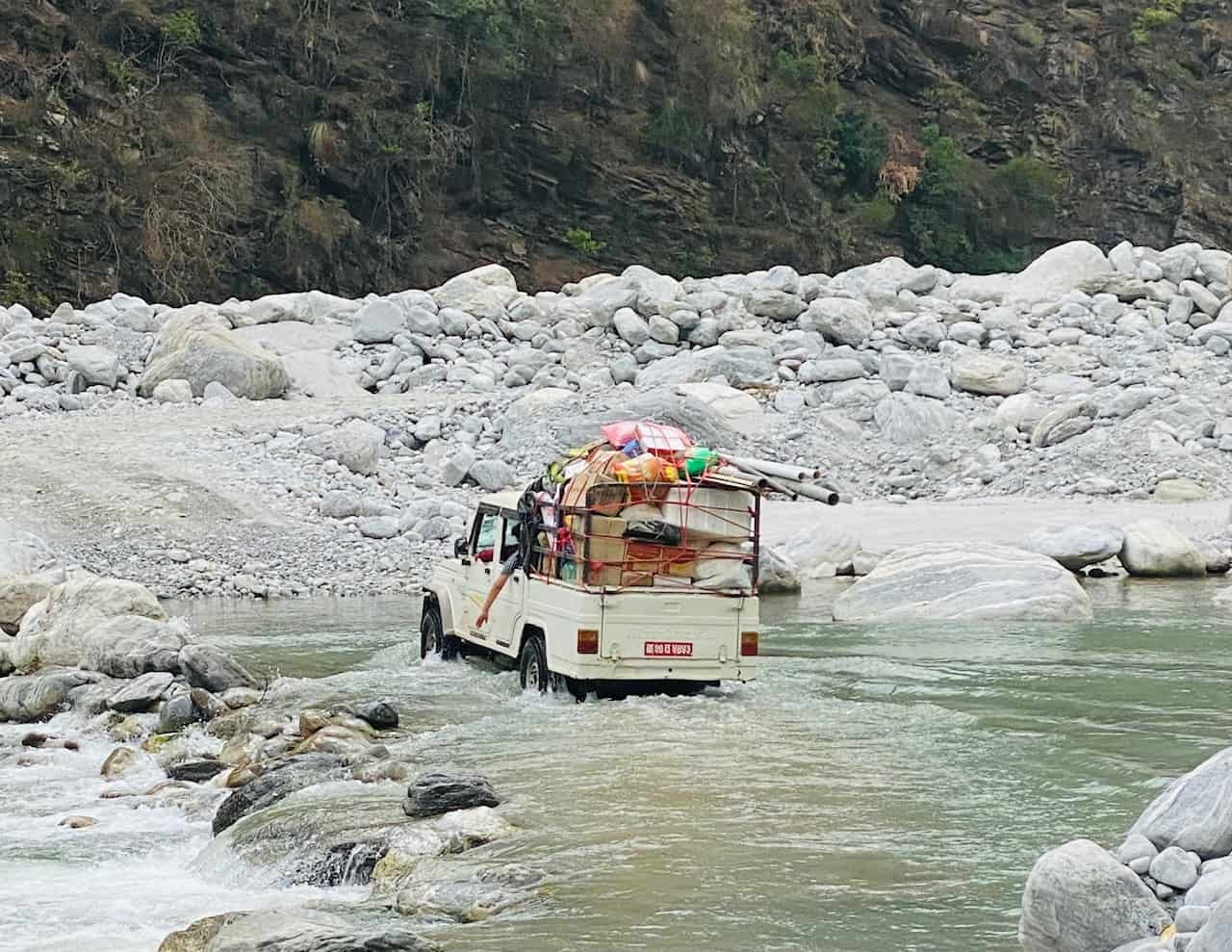
Mutig stürzen wir uns in

Aber – wir schaffen es unbeschadet!

Die Zerstörung ist unfassbar – Man kann sich das Leid der ohnehin leidgeprüften Nepali nicht vorstellen!

Die letzten Impressionen…

praktisch nicht mehr wieder

Frauen gehen am Flussufer – oder das, was mal das Flussufer war…

Man erkennt praktisch nicht,

Häuser ragen gespenstisch aus dem Flussbett heraus. Hohle Augen schauen uns an…
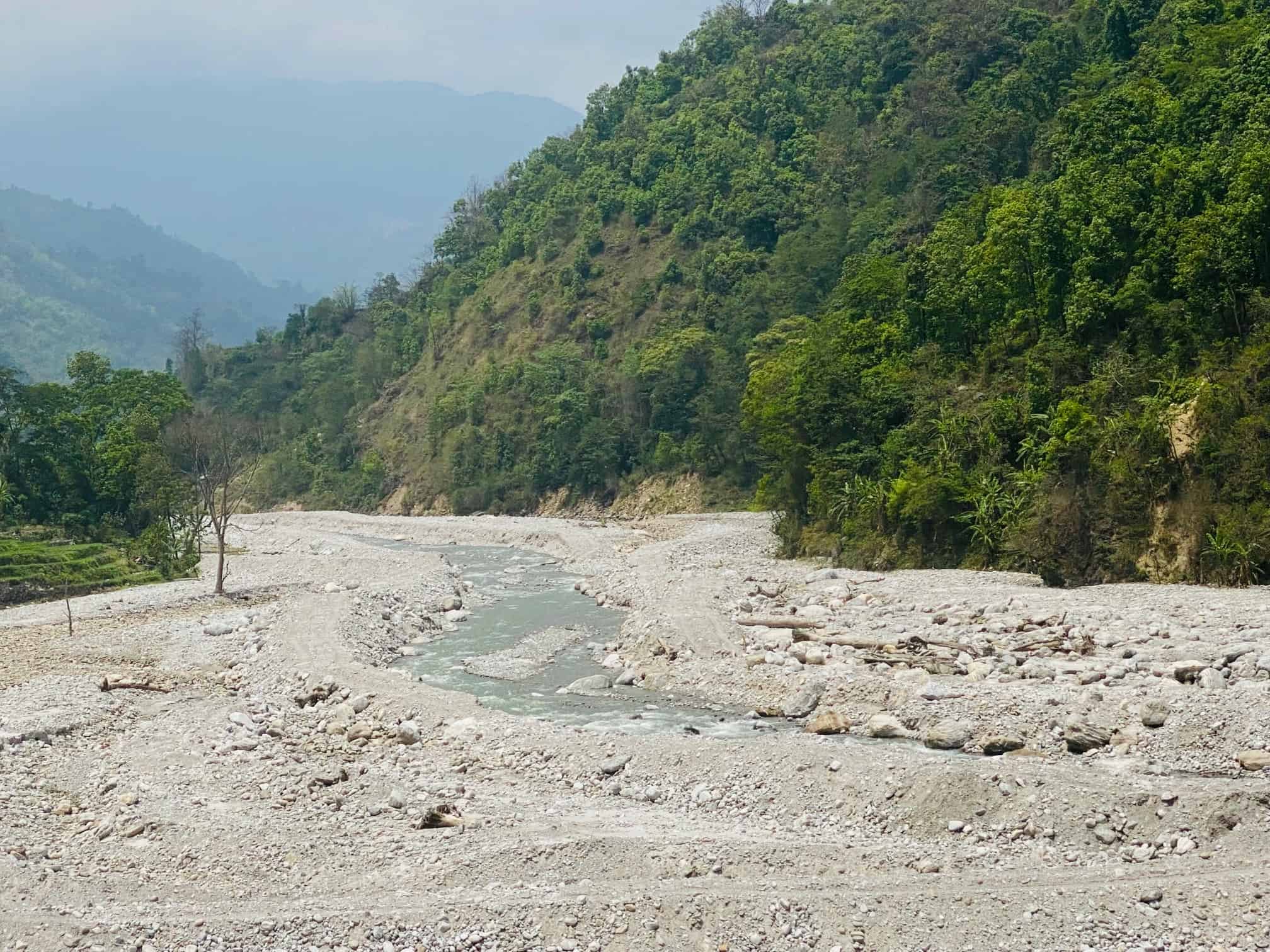
Schwierig vorstellbar, dass dies mal ein grosser Fluss, der Melamchi war.

die Fluten. Ich habe Angst, dass wir

Immer wieder riesige Felsbrocken im Fluss

Aber noch schlimmer ist, dass die Regierung…

Bevor wir mühsamst in Timbu ankommen

Geröllblöcke überall

Dieser Ausblick ist irgendwie noch tröstlich – täuscht aber…

was dort gewesen ist…

Waren das Neubauten oder fehlen die Tore?

Jetzt wird es spannend: Wir müssen durch ein Flussbett fahren…

irgendwo stecken bleiben…

Ich komme mir vor wie auf dem Mond!

seit 9 Monaten fast NICHTS gemacht hat!!! Eine einzige Brücke hat sie behelfsmässig gebaut!

Mir gehen die Worte aus…
– Die Foto-Strecke 3 –
Timbu – eine neue Überrachung wartet

Aus der Ferne wirkt alles normal

From close up it is quite unkempt

… and are horrified! Here is for months

Mein partner Lhakpa und Sohn mit Freundin

I am still in good spirits…
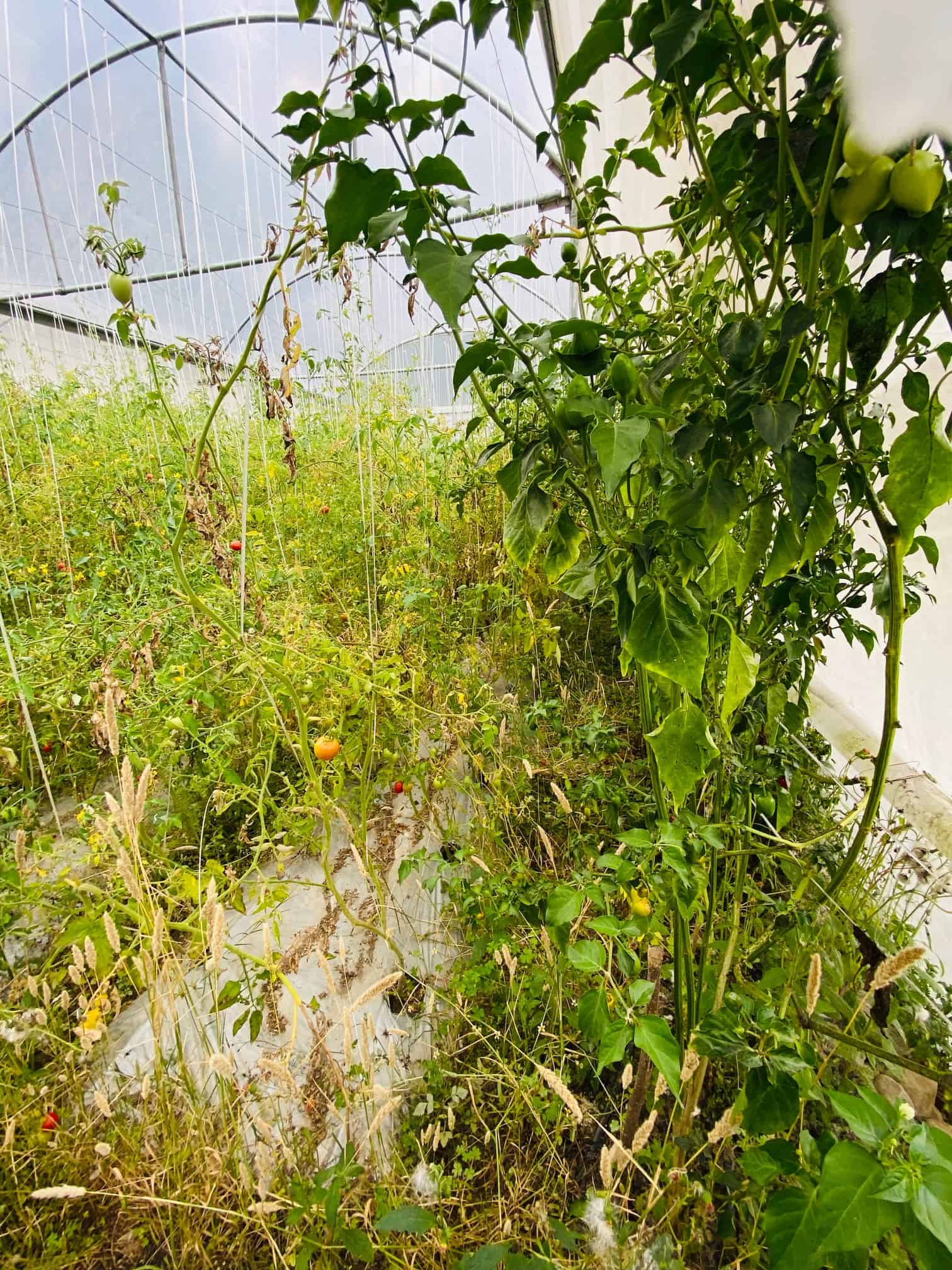
nothing has been done…..
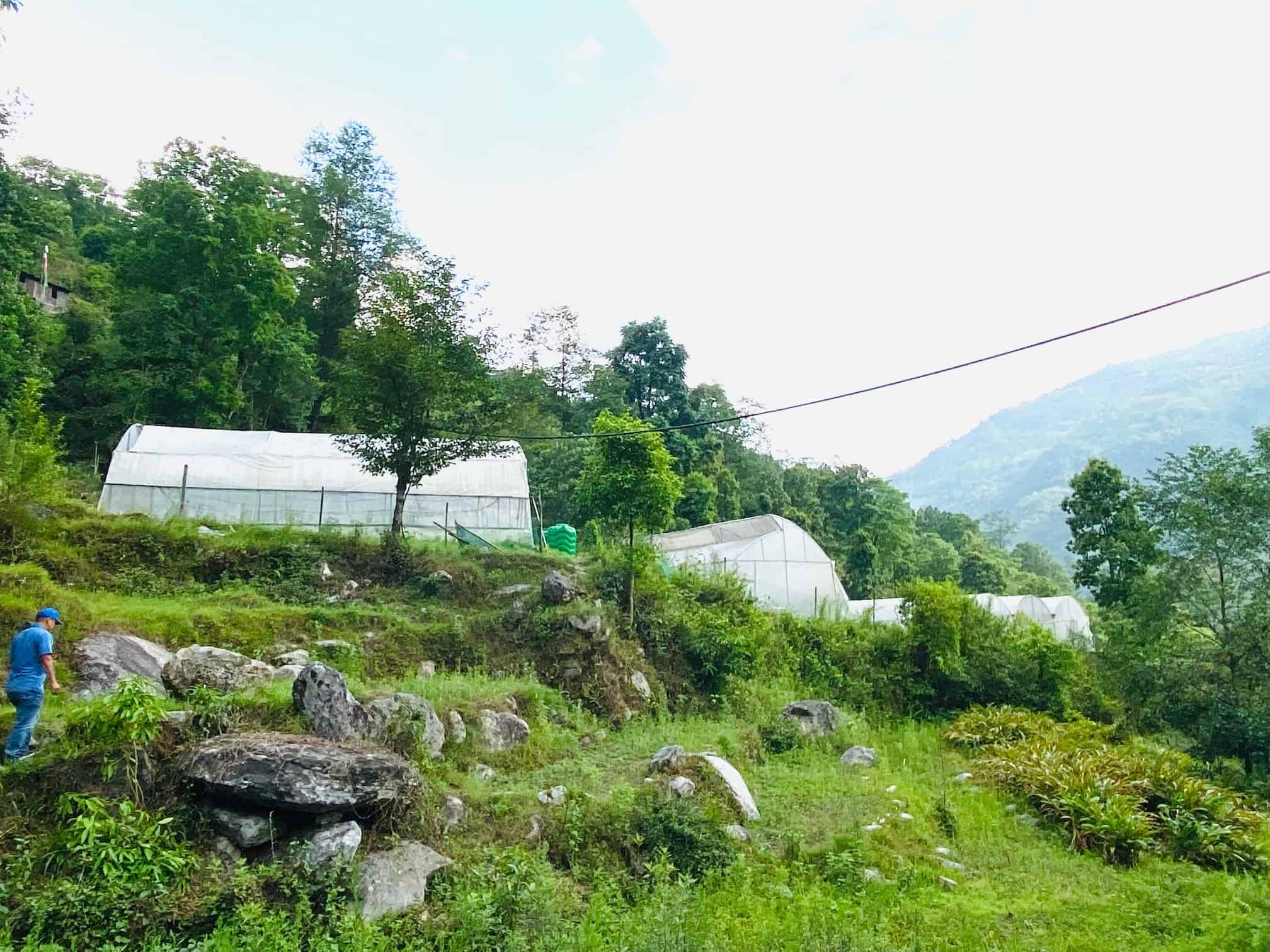
Auch dieses Bild sieht gut aus

We will take a look inside the…

Below Lhakpa’s house there is now a new fish hatchery!
The year 2021 until the spring of 2022
After we were able to add 2 greenhouses in 2020, the year 2021 was marked by another catastrophe. As if Nepal was not already “shaken” enough, in the summer of 2021 the monsoon was so strong that the river Melamchi, which runs between Kathmandu and “our” Timbu, swelled so much that ALL bridges over the Melamchi were torn away. Thus, as of August 2021, there was no more access to Timbu, except on foot in several day marches over the mountains.
Thus, with regard to our further plans, our “hands were tied” and we could do nothing, except keep in touch by phone. Nevertheless, the women of the cooperative did not give up and continued with the 4 greenhouses! They were able to sell the vegetables in the surrounding area and also in their own village.
Only at the end of 2021 and the beginning of 022 the Nepalese government started to rebuild a first highway bridge over the Melamchi in Melamchi city! Before that HELVETAS Switzerland had helped to install some suspension bridges, so that at least pedestrians could cross the Melamchi again! For us this was of little use, because we have to transport construction material for our projects.
On April 25, I will travel again to India and then to Nepal, the first time since 2 1/2 years “Corona break”. Then we will see how to continue with our next sites, the Guesthouse and the Eco-Café.
Here are some more pictures from Timbu in March 2022, which we received from the residents. They show very nicely that the women are eager to keep their greenhouses running even without our presence!
On April 25, I will travel again to India and then to Nepal, the first time since 2 1/2 years “Corona break”. Then we will see how to continue with our next sites, the Guesthouse and the Eco-Café.
Here are some more pictures from Timbu in March 2022, which we received from the residents. They show very nicely that the women are eager to keep their greenhouses running even without our presence!

The greenhouses seen from a distance
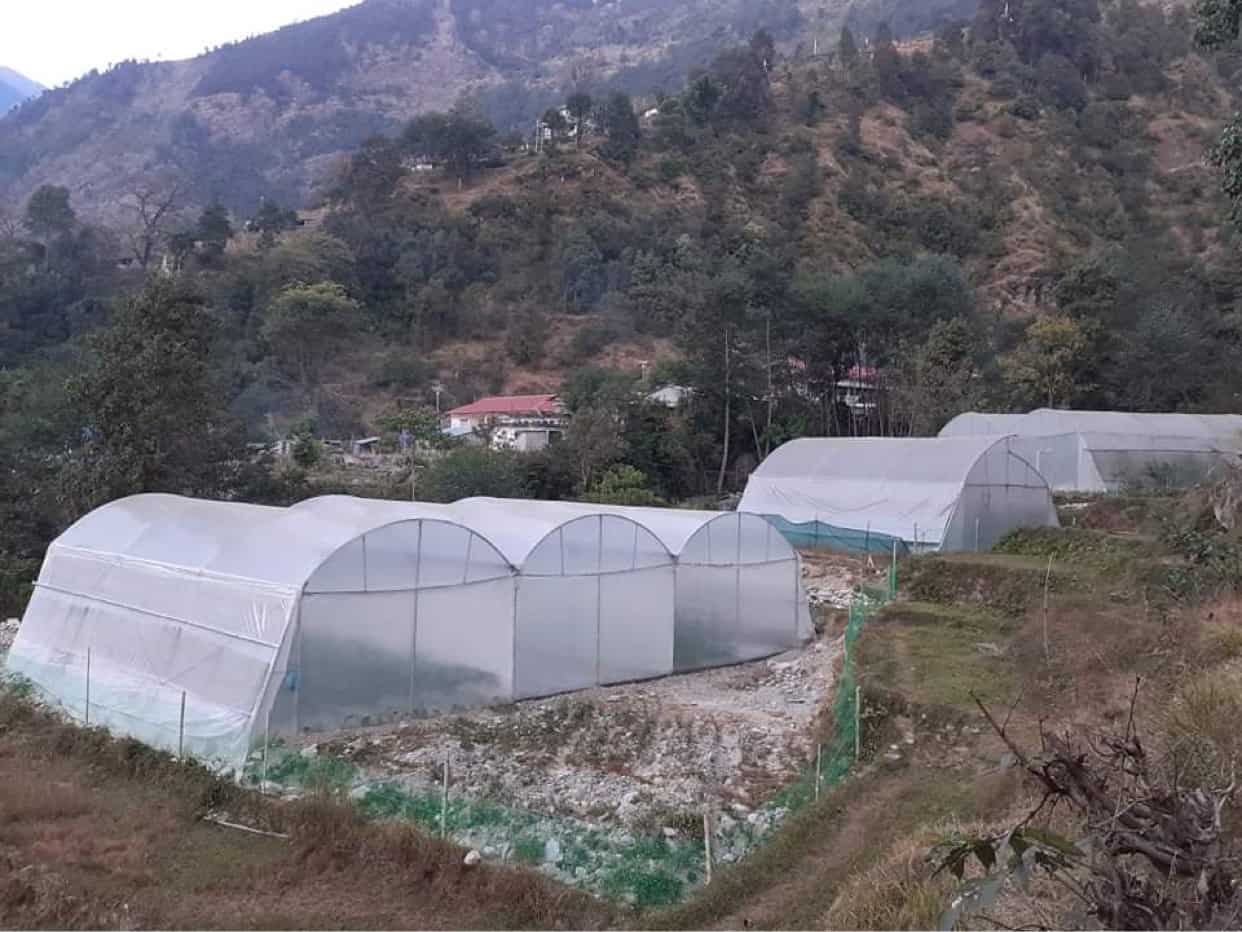
You can see very nice the protective fence around the greenhouses

The greenhouses were also damaged in the monsoon of 2021

The men in the village did a super job repairing the greenhouses themselves

Are peas also planted here (organic)?

The beginning of planting 2022

The women have learned to mulch in the previous two years!

The tomato plantation comes up very healthy! The women have learned a lot at Nepal Agro Life!

The tomatoes are growing so really well!

The slips show the planting dates

In March come the first tomatoes

It looks like a good harvest!
The devastating monsoon in August 2021
As if Nepal had not already had enough disasters! Now the monsoon in August is so strong that all bridges over the Melamchi River have been washed away.
But – the Melamchi River separates the valley from Kathmandu and the LangTang National Park, on the edge of which Timbu is located: Thus, there was no getting through to Timbu anymore until spring 2022!

The Melamchi, overflowing with this monsoon washes everything away!

Situation in Melamchi Bazar
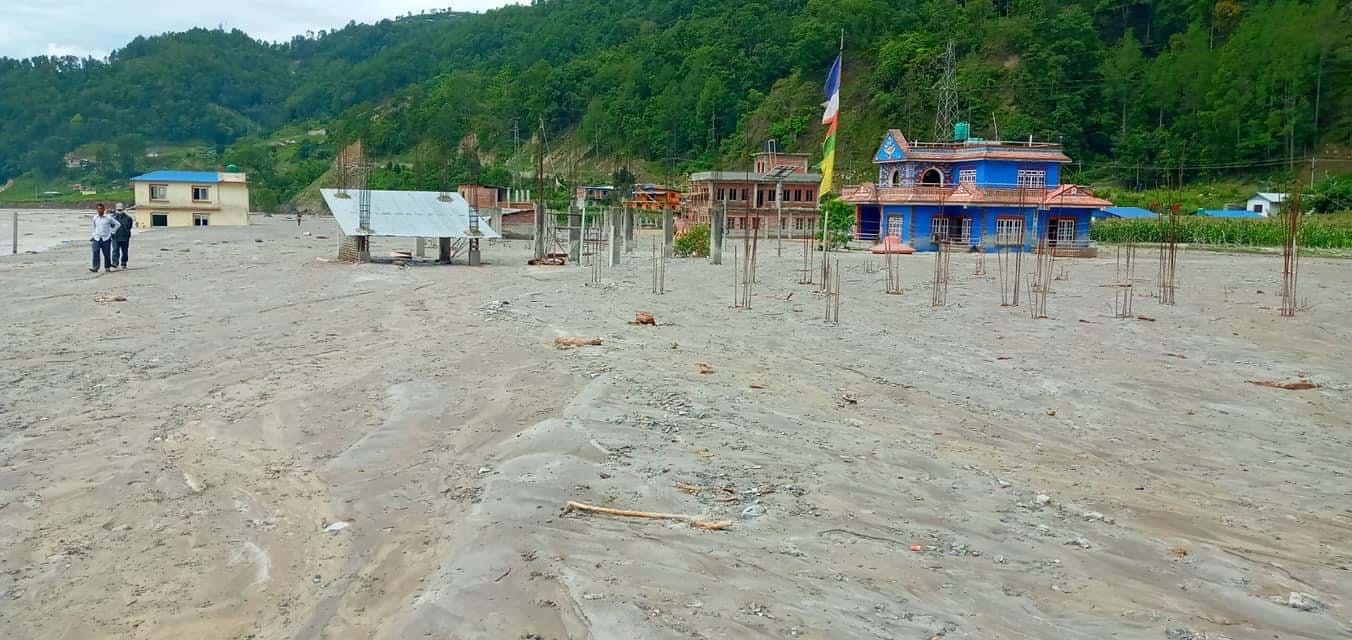
Not only were the bridges washed away


Also, many of the houses near the shore simply “floated away”

The year 2020
After the first “Corona despair” we discussed for a long time with Nepal Agro Life and our partner Lhakpa Lama and then decided to build again 2 big greenhouses, despite Corona problems and -lockdowns!
Background: The “Woman’s Association” (35 women from the village with 85 families) explained to us (actually already last year) in an understandable way that 2 greenhouses would not be enough to sustainably produce so many more vegetables that there would be enough income in total in the village to also employ and keep the young generation.

In August, the two new greenhouses are up! This was an act of violence during the Corona crisis and multiple lockdowns in Nepal! Rajan has even found an agricultural engineer in the benachtbarten Melamchi so that he would not have brought from Kathmandu possibly Corona.

You can see very nicely the construction with weather-resistant polyethylene and stable metal construction. These greenhouses can stand comparison with Europe and provide our women’s cooperative with a good additional income!

Here you can see all the greenhouses after completion in autumn 2020. Because of Corona, everything was delayed a bit and the start of construction was only in June 2020, because the materials came from India and were stuck for a long time at the border with Nepal.

Tomatoes are also thriving in the new greenhouses. Here, too, there are additional plantings on the sides with green leafy vegetables, cauliflower and other vegetable species or even garden herbs
October 2019: The inauguration of the first two greenhouses
The first tomato crop was harvested. The women’s cooperative was able to sell them well.
And – they have not only grown tomatoes in the greenhouses, but also cauliflower and green vegetables on the unused sides of the greenhouses.

The first two greenhouses – October 2019 – At the time, I couldn’t imagine it would be 2 years before I could travel to Nepal again….

At the beginning of October 2019 we will celebrate the inauguration and first harvest of the two greenhouses: Rajan from the company NEPAL AGRO LIFE will be there, without whom the greenhouses would not exist…

The president of the Woman’s Association gives Rajan a big bag of tomatoes as a small thank you for all the help!
After all, he and his team had come to Timbu 6 times, first to build the greenhouses, but then for training and cultivation assistance! For example, the women learned how to make organic fertilizer and plant protection.

There was another big round for the final meeting with all 25 women of the cooperative. We were all very honored and thanked, but there was also a critical review of the first part of our project. Even then, the women expressed their concern that 2 greenhouses would not be enough to sustainably improve the village income!

Our partner in Nepal, Lhakpa Lama, is also President of the Board of the Snowland Children Foundation Nepal. Besides Bianca-Maria, president of the foundation board of SCH in Switzerland and Rajan, the managing director and owner of Nepal Agro Life in Kathmandu, which has carried out the organization and construction of the greenhouses.

Coincidentally, Swiss friends who have been traveling the world for 2 years were also in Kathmandu. They spontaneously accompanied us to Timbu! Sophia, their 6-year-old daughter would love to eat all the tomatoes!
The entire project description,
from the beginning of the activities in 2015 until April 2021
At the end there is a photo track about the whole project!
Everyone who loves the Himalayas and the countries there can remember the devastating earthquake in Nepal in April 2015! There were 2 epicenters and one of them was located in Helambu, an area northeast of Kathmandu, where the Lang Tang National Park is also located. The quake there went all the way to Kathmandu itself, where the upper part of the largest Buddhist shrine outside of Tibet, the Bouddanath lost its entire upper part. For years to come, during the construction work, one could see how terrible the devastation had been. In Kathmandu itself, even years after the earthquake, there was a tent city where people lived who had come from the surrounding villages where they had lost everything or even from Kathmandu itself, where several buildings had also collapsed.
In Helambu there is also the village of Timbu, where our two Tibetan-Nepalese partners Lhakpa Lama and Urkin Sherpa have good relations: Their families are originally from there, although they themselves have been living in Kathmandu for many years. Lhakpa built a new house in Timbu a few years ago, one of the very few (over 90% of all houses were destroyed) that was not completely destroyed in the 2015 earthquake. Thus, Lhakpa and Urkin know the most pressing needs of the village population. Thanks to their good local knowledge and excellent contacts with the local population, we have been able to implement our previous projects with the least possible financial resources.
In the meantime, Lhakpa has also established a foundation in Nepal: The Snowland Children Foundation Nepal, so to speak as a sister foundation of our foundation and – of course – financially dependent on our foundation. The advantage of having our own foundation in Nepal is that – we hope – one day we will be able to negotiate better with government agencies there and act independently.
There are – after the rural exodus after the earthquake – still 85 families living in Timbu, which is located at an altitude of 1,340 meters. It is one of the remote villages found in the hills at medium altitude in Nepal. It has a large catchment area with many very small hamlets or clusters of houses located further up the mountains. It takes several hours to get to some of these settlements by four-wheel drive jeep. But – even to Kathmandu, which is actually only 65 km away, you still need practically a whole day, because the roads in Nepal are so bad that you would be much faster with a horse. Timbu is nevertheless connected to Kathmandu by a bus line that leaves almost daily at 6:00 in the morning, but also takes the whole day.
In the first years after the earthquake nothing really happened in the completely destroyed villages. People lived in tents or later in makeshift corrugated iron houses. Many of them can still be seen today, 5 years after the severe earthquake. Many people have also moved away, and the question arises: How and from what do they live elsewhere? They have no money in our sense, they lived on the few grain, fruits and fruits, which their country gave. Some were able to find shelter with relatives in Kathmandu, where they all had to live even more cramped and with less than before the earthquake. Some of them ended up in the already mentioned huge tent camp in the middle of the big city.
There is less and less work for the many people in Kathmandu. Therefore, almost all of the young people are sitting “on packed suitcases” in the hope that one day they will be able to emigrate to the USA, Australia or Europe. Only – especially in Europe – the situation there has become extremely difficult in the meantime with the large streams of refugees from the East and Africa.
But also in 2020 there are still destroyed houses. 2 years ago the Nepalese government finally started to give some money to the people. After the earthquake they had received millions of dollars from many governments and relief organizations, of which until today nobody knows where they have remained… A maximum of 4,000 $ could be given to a family if they could prove that (1.) they had lived in one of the earthquake villages and, above all, that they were still living there and (2.) that they had already laid a foundation for a new house. But – where should they get the money for the foundation plate? So it still continues to this day that new houses are built quickly.
There has also been a lot of “fuss” about “earthquake-proof house construction” in our country, well-known NGOs have sent specialists. Maybe there are also some villages with such houses, but – in the normal case – the villagers build the houses as before, only less beautiful, because with concrete and less wood, so probably rather less earthquake-proof than before.
Even otherwise, the activities of the known NGOs are mostly limited to large posters at the village entrance about hygiene when washing hands and going to the toilet, just to build earthquake-proof houses and waste disposal. However, in 2016/17 Helvetas Switzerland installed a new water pipe in “our” village.
Snowland Children Foundation itself funded two community houses in Timbu and Embalama (a small hamlet located another 2 hours above Timbu) in 2016 with the first donation money. Then in 2017 we built a water pipeline in Embalama and in 2018 we also helped to build a school (Kakani) there. Thereby we were responsible for the exterior works and the shoring up of the steep mountain slope (for details see under
“Success 2016”, 2017 First projects of the Snowland and 2018 The Kakani School Project
All actions in Nepal were only possible thanks to the initiative “One village helps the other” of our village Bichelsee-Balterswil (Thurgau). In 2017, we held the first benefit evening as an “ecumenical group” under the leadership of the Catholic pastoral area leader Daniela Albus. In 2019, a second event followed. Both were so successful that each time about 15,000 CHF were raised. But there were also other actions such as the “Fightsport-Night Wil” by Tenzin Shitsetsang (with 12,000 CHF!), the carol singers in Eschlikon (Thurgau) 2017 or the carol singers in Toggenburg 2019. We ourselves have been conducting Tibet evenings at Cinewil in Will since 2016 and can already look back on 11 successful film evenings!
In Timbu itself, besides the water pipeline, only the completely destroyed secondary school was rebuilt by Caritas, Switzerland, in 2018/19, but this was done quite magnificently and almost too beautiful for the conditions there.
What is our goal now for the Eco-Farm and Co?
The Snowland Children Foundation wants to contribute to stop the rural exodus, but also the rural exodus of the young generation! In Kathmandu, there is more and more crampedness and also poverty, THAT can not be a future. We also work here for and with Tibetans, who did not flee from the Chinese, but emigrated from Tibet several centuries ago.
The 10,000 or so Tibetans (with Nepalese passports) are one of the minorities in Nepal. They are not to be confused with the many Tibetans who have fled from Tibet to escape the Chinese, who live underground in Nepal and hope to leave for India or other countries. These Tibetans are living more and more dangerously as the communist government in Nepal is becoming more and more dependent on the Chinese and, according to recent treaties, has agreed to extradite any Tibetan the Chinese want to repatriate. The exit is so difficult because the Tibetans in China do NOT get a passport!
With the Eco-Farm we will hopefully be able to show not only the 85 families in Timbu, but the total of 10,000 people in the Helambu region, that it is worthwhile not only to stay in the country of Nepal, but even ON the land. We want to show that you can earn so much money with organic vegetable production that you can live a good life even in a remote mountain village, probably much better than in the overpopulated big city of Kathmandu. You have to show especially the young people that it is worthwhile to build up an existence in the countryside instead of surviving without a job and in poverty in the city.
We have started 2019 with 2 large greenhouses
The land, which we need for this, has been lent to the already existing cooperative in the village, the “Womans Association”, by the owners free of charge (on a contractual basis). Part of it belongs to the men of the women in the cooperative anyway.
Since the first harvest at the end of 2019, they have been distributing the organic vegetables with the help of our opartner Nepal Agro Life. This was already the first year very successful!
Also the youth is working with us, organized as “Helambu Youth Club”! In the course of time we would like to create a whole Eco-Farm, build a guest house and establish an Eco-Café, which will be available for trekking tourists of the Helambu region, but also for the village population and volunteers. Furthermore, we plan to one day hold a weekly market there for the larger population and also to build a kindergarten.
The planned greenhouses must be stable, since there have been major incursions of monkey hordes in this area since the earthquake and increased rural exodus. In addition to the monkeys, there are also increasingly frequent wild boars that destructively invade here! And of course the greenhouses should be able to withstand the annual monsoon rains in summer, which means that the polyethylene used must be very strong. Aks additional protection Nepal Agro Life has built a bamboo fence around the greenhouses.
After the now established Nepali-Branch Snowland Children Foundation Nepal signed a contract with the Woman’s Association with now 35 members (in 2018 there were still 25 Miglieder, the success of the first greenhouses has increased them by a third!) to use the land, we built two greenhouses as a first in 2019!
After extensive training of the women and familiarization period, in the fall of 2019 the responsibility was handed over to the Woman’s Association, who will run the greenhouses on their own in terms of production and marketing of organic vegetables.
In 2020, we then built 2 more greenhouses at the request of the women despite Corona problems. The company Nepal Agro Life has done a superhuman job to complete this second project by early 2021 despite Corona! They will continue to accompany and support the project technically and organizationally to the best of their ability.
Company Nepal Agro Life as a partner:
With the company Nepal Agro Life we have found a competent partner in Kathmandu, who has stood by us during the construction of the greenhouses as well as the training of the women of the “Woman’s Assiciation” in Timbu and still does in 2021: They were in charge of both projects from the planning of the greenhouses to the first marketing of the organic vegetables. They have organized the construction of the greenhouses, additionally conducted 2 x 6 trainings (2019 and 2020) with the women of the “Woman’s Cooperative”, monitored and advised on organic fertilization, and organized the first tomato plantings. This company is made up of agricultural specialists who have experience with greenhouses and the cultivation of organic vegetables in remote areas of Nepal.
Despite higher costs, we have decided to this cooperation, because we ourselves are not specialists and also can not be constantly on site! And – it had already been very worthwhile in 2019, as one of our direct partners had developed a brain tumor. This was fortunately benign, but had nevertheless forced him into time out for 4 months after successful surgery.
At the beginning of October 2019, we were together (Nepal Agro Life, Lhakpa Lama and myself) in Timbu for the last time and could celebrate the completion of the first project phase after the 6th and last training of the women!
In 2020, the 2nd project was carried out without a visit from Switzerland, just as successful as the first time, slightly delayed because of Corona. In the fall of 2021 it will probably be possible to travel to Nepal again without any problems (vaccinated and with a negative PCR test).
Cost-expense 2019
For the construction of two greenhouses with the dimensions of 16 x 9 and 15 x 10 meters we needed a budget of about 13,000 CHF. The price included the 6 trainings of the women of the cooperative, the planting, the organic fertilizer, pest advice and the ongoing advice and help with the first marketing.
Cost expenditure 2020
Thanks to the donations we received until the end of 2019 (almost 50,000 CHF), we could easily finance the2 wfurther greenhouses with this time around 14,000 CHF (because of the soil conditions, the effort was greater, also the import of the materials from India had become more expensive).
Planning 2021
We still have enough money in the budget in 2021 (about 19,000 CHF) to start the next phase of the Eco-Farm:
We plan to build a “Guesthouse” for volunteers but also trekking tourists and other visitors. Besides, we will tackle the Eco-Café, which will also be for the villagers but also for the volunteers and trekking tourists.
The plan is to involve the young people of the “Helambu Youth Club” in their free time, who in return will receive support from their local youth club. Since there are no other activities for young people in this area, this reciprocal support seems very important to us. It will hopefully become really lively when we start to organize a weekly market for organic vegetables. But – these are still dreams at the moment…
First of all we have to see that the other projects are running. The first two projects “water pipe” and “Kakani school” can be found under “Success 2017” and “Success 2018”.
Before we started with the greenhouses, some grain was grown. Now that the greenhouses are up, the women can also improve the soil around the greenhouses with humus. There they want to grow cauliflower and other plants, which do not necessarily have to be in the greenhouse.
In the fall of 2021, I will hopefully be able to travel to Timbu again myself to directly document what went on last year and this year!




What does the Snowland Children Foundation guarantee?
The SCF guarantees that every project-related donation franc also goes into the selected project. Each step of the construction of the greenhouses will be documented by our partners and controlled 2 times a year by the foundation president herself on site (exception Corona-conditioned 2020 and spring 2021). These trips are privately financed by the president. All important information is subsequently documented on the webpage. Very current information and the ongoing trip report are communicated via Facebook (Snowland-Children). For any donations, donation receipts can be issued for tax purposes, a the foundation is recognized as a non-profit.
The Foundation is registered in the Swiss Commercial Register and is tax-exempt. Furthermore, it is under the supervision of the Swiss foundation authorities. Since 2018, the Nepali Branch has been registered in Nepal and is also under the supervision of the authorities there.
Two recent reports in the village newspaper Bichelsee-Balterswil (in German): NBB_06_2019_Benefiz and NBB_09_2018_Nepal
Where we help and our local partners.
Click your way through (in German)!
Wo wir helfen – unsere Helfer vor Ort (PDF, german)
Photo gallery about the construction of the 4 greenhouses 2019 / 2020
Photo gallery about the construction of the new greenhouses 2020
( August – September – October 2020, starting with August )

This time the land for the new greenhouses is very sloping.
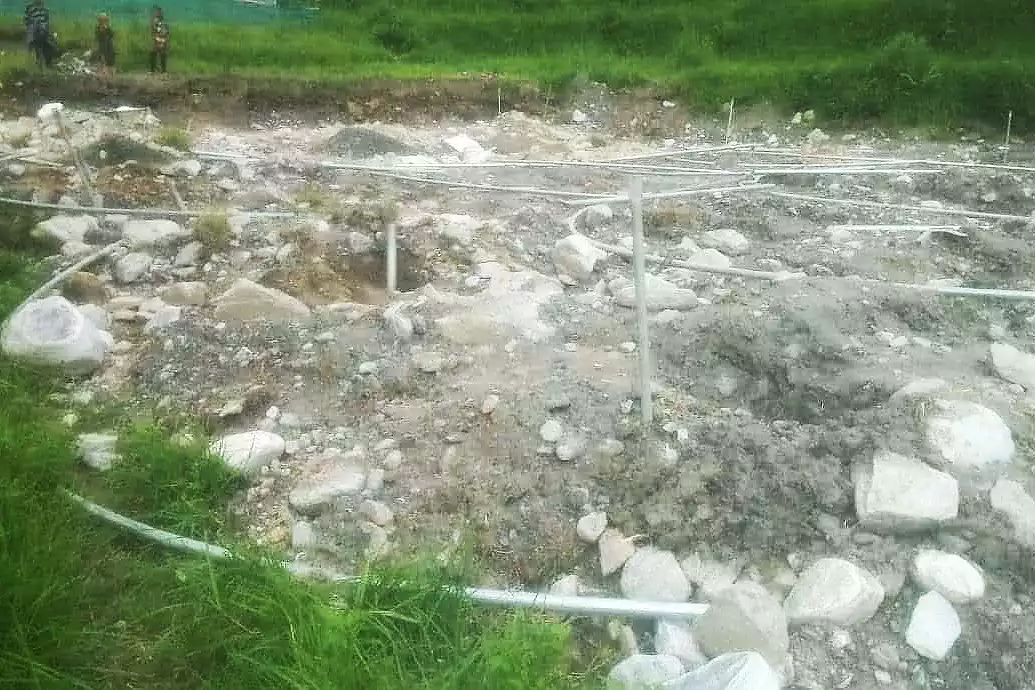
The land must first be leveled at great expense. A wall even has to be built so that the water cannot run off too quickly!

The land must first be leveled at great expense. A wall even has to be built so that the water cannot run off too quickly!

Once started, the construction of the greenhouses goes very quickly! But – it is not possible without the help of the village!

But – also this time the members of the youth organization have to help so that it goes well.

And this is how the whole thing (with the first greenhouses) then looks finished.

The women have planted tomatoes again, which come very well!

Nepal Agro Life specialists also had a critical look at the first greenhouses of 2019

Besides tomatoes, they also planted bitter gourd (Bitter Gourd)
Photo gallery about the construction of the new greenhouses 2020
( September )

In September, the “Drip Irrigation System” is installed. This saves water and nutrient losses by delivering water drop by drop directly to the roots. It also prevents waterlogging

The installation of the system

The prepared beds are covered with mulch sheets to keep moisture in the soil. Mulching also helps against weeds and keeps the soil healthier overall.

The women have already grown the tomato seedlings themselves with last year’s experience!

Nepal Agro Life specialists also had a critical look at the first greenhouses of 2019

Here you can see very nicely the laid out mulch foils to prepare the beds for planting. Rajan is excited about what the women remembered from last year’s “exercise”.
Photo gallery about the construction of the new greenhouses
( October/November 2020 )

The agrotechnicians of Nepal Agro Life and the women of the Woman’s Association have finished planting tomatoes and beans

The seedlings, which the women had grown themselves, are thriving very well!

The bamboo fencing of the old and new greenhouses is ready. There is only one entrance to better protect the complex

The preparation of the oranic (organic) fertilizer goes quickly and easily with the experience of last year

Also this year the women have put cauliflower between the tomatoes

On the sides of the greenhouses they plant green leafy vegetables

Here you can see very nicely the diversity in cultivation. The women have learned a lot last year and not forgotten!

Nepal Agro Life had also proposed fruits like strawberries for last year’s greenhouses. But – the women stay with tomatoes etc. for the time being, because they sell very well.

Besides, they think that now they want to gain experience with vegetables first, which is very reasonable
Photo gallery about the construction of the two greenhouses 2019





Training must be at every visit

Coming soon coriander and cauliflower
Photo series on the construction of the two greenhouses: August 2019


The tomatoes stand well




Photo series about the construction of the two greenhouses: July


The greenhouses as they appear in July


Work is done even in the rain

The women prepare organic fertilizer according to instructions

Organic plant protection products are also produced in the same way



The first planting is done
Photo series on the construction of the two greenhouses: June





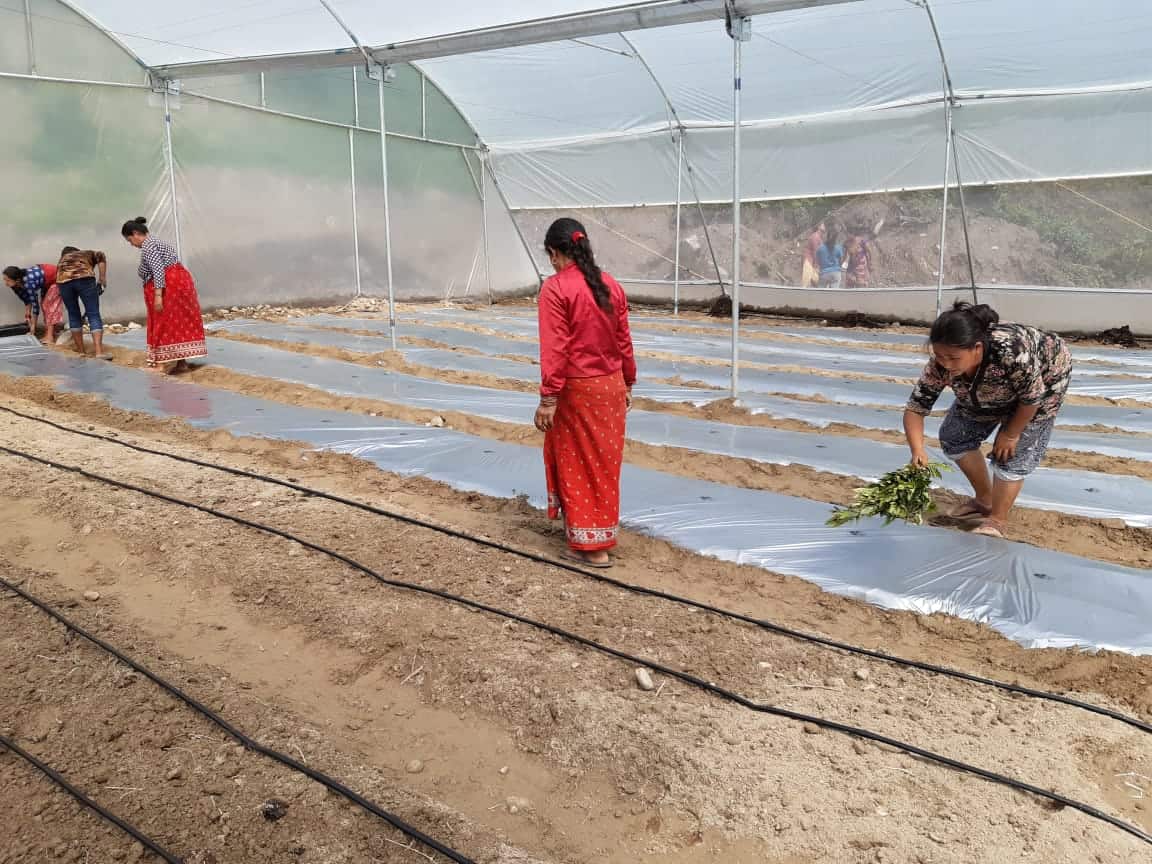


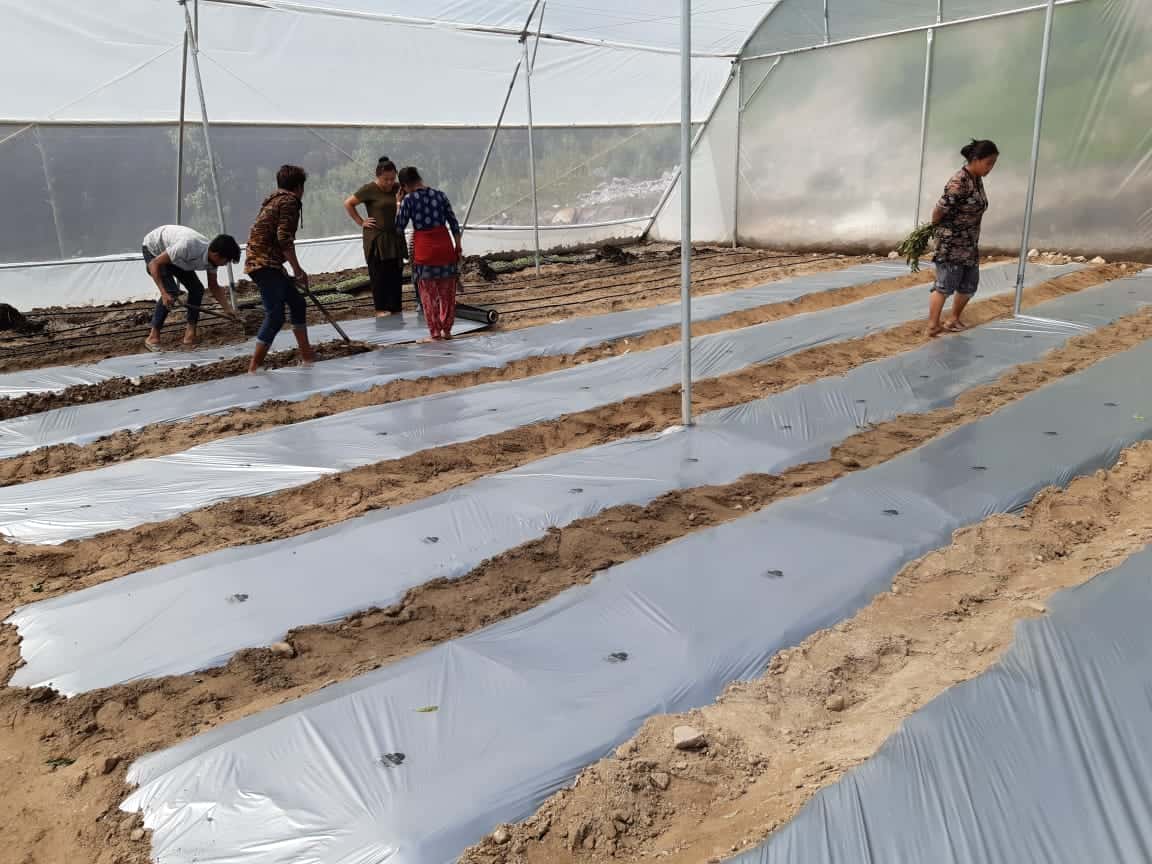
It starts with pulling the rows and then mulching. The micro-irrigation system is also already working well!
Photo series on the construction of the two greenhouses: the beginning until May 2019.



This was the beginning, early June 2019



The site plan, you can see the higher house with the SCFN office on the 2nd floor.



Here come the greenhouses in – situation may 2019
Our partners in Timbu

Our partners, Lhakpa and Urkin

Lhakpa has dedicated his life to village preservation

Urkin himself comes from the village

Urkin checks a Timur (pepper) sapling

Lhakpa in our private car

They also hope for the future!

The Women’s Cooperative in Timbu

The youth club that will help

They are the future!

With my partner Urkin

And again and again negotiations in Kathmandu

Our partner Lhakpa in the only guesthouse of Timbu, the cook is his friend
This is how it still looks in 2019 during our last visit to Timbu: The aftermath of the 2015 earthquake can still be seen everywhere!

View of today’s Timbu, from below against the mountains where the earthquake has cratered

The village temple looks the same as in 2015…. We had bought supporting pillars in 2016, but that’s it….

A view of Timbu from close up, you can clearly see the only makeshift repaired houses, plus tin huts

Everywhere there are still primitive tin huts, as they were after the earthquake.

Living in this form is terrible: hot in summer, freezing cold in winter, most often they have no windows …

Most of these most primitive dwellings have no toilets or running water

My partner Lhakpa, a brother of my friend in Switzerland Dolma and I privately financed this stupa

Lhakpa’s private house (he himself lives in Kathmandu) has miraculously survived severe damage. The Eco-Café is set up here

A ray of hope: Caritas Switzerland has built this interregional secondary school in 2018/19! Here volunteers can help in the classroom!

This is also the only “guest house” in 2019: Here we want to help with the Eco-Café

This is what the “kitchen” of the inn looks like – all open to the front and a single table!

Like almost everywhere in the Himalayan countries, alcohol is a big problem – and you can buy it cheap everywhere!

This is what it still looks like in many places in Helambu….

The “main work” of the big NGOs: posters about hygiene and earthquake-proof building at the village entrance… Real help would look different…

